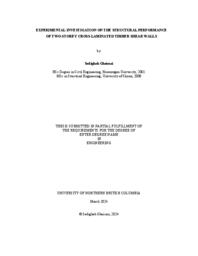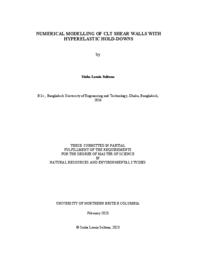Pan, Yuxin
Person Preferred Name
Yuxin Pan
Related Works
Content type
Digital Document
Description / Synopsis
Rapid urbanization has led to an increasing demand for sustainable living and working spaces. In response, renewable materials like wood, especially in the form of Cross-laminated timber (CLT), have gained traction due to their sustainability, cost-efficiency, and versatility. However, there remains an insufficiency of experimental tests on multi-storey CLT structures, and the limited studies conducted so far have predominantly used conventional light frame connections. This thesis is centered on evaluating the performance of two-storey CLT shear walls with self-tapping screw (STS) connections, addressing a significant research gap. The research involves experimental tests conducted on two-storey CLT shear walls, with a focus on the effect of the shear connections between floors and tension strap connections as well as the effects of acoustic insulation layers and the presence of perpendicular CLT shear walls on the structural performance. Load-displacement curves showed linear behavior up to the intended lateral displacement, with STS-connected CLT shear walls meeting NBCC drift criteria of 2% height of the structure. Rocking was the primary factor influencing lateral displacement, with tension straps playing an important role. Strengthening shear brackets and adding dead load increased load-carrying capacity by almost 25%. Screw installation angle at tension straps had minimal impact. Also, test results showed that the addition of an acoustic layer had a slight adverse effect, while perpendicular shear walls boosted load-carrying capacities by 15%. In addition, Sliding contributed about 10% to lateral deformations. Panel distortion was minimal, affirming rigid body behavior, and CLT panels acted as rigid diaphragms. This study findings provide valuable insights into the behavior of CLT shear walls, highlighting the importance of appropriate tension strap connections and detailing.
Origin Information
Content type
Digital Document
Description / Synopsis
The provisions of CSA O86 (2019) for Cross-laminated Timber (CLT) shear walls recommend the design of non-dissipative hold-downs with sufficient deformability to facilitate wall rocking. A hyperelastic hold-down system was proposed to satisfy these criteria. In this study, a numerical model was developed to capture the behaviour of CLT shear walls with the hyperelastic hold-down system using data from previous component level and full-scale shear testing. Six hold-down configurations were calibrated using the software OpenSees. Different modelling approaches were attempted; ultimately, a back calibration approach using the shear wall test data produced acceptable results. Calibration parameters were derived for the OpenSees ‘Hysteretic material’ for each hold-down configuration utilizing data from six tests on shear walls with un-coupled panels, and validated with the results from twelve additional tests on shear walls with coupled panels. The average differences between test and model for corner uplift, force at peak lateral displacement and energy dissipation were found to be 7%, 12% and 11%, respectively. A set of equations were proposed to predict calibration parameters of untested configurations. Finally, a two-storey platform-type shear wall was designed and modelled applying the calibrated Hysteretic material for the hyperelastic hold-downs. The developed model can be used to predict the shear wall performance of un-tested configurations.
Origin Information
Content type
Digital Document
Description / Synopsis
Cross-laminated timber (CLT) is becoming a feasible alternative as structural material for midand high-rise buildings. Although CLT walls are appropriate for resisting lateral loads from wind and earthquakes, the current provisions in the Canadian Standard for Engineering Design in Wood lack analytical expressions for estimating their resistance and deflection. In this thesis, the performance of nailed single and couple CLT shear walls is investigated by comparing UNBC test data with the strength and stiffness predictions using analytical proposals. Four methods are considered: Method A (Casagrande et al. 2017), considers the minimum strength value of the hold-down and the vertical fasteners; Method B (Shahnewaz et al. 2019), which accounts for the rocking resistance of all connectors; Method C (Masroor et al. 2020) which accounts for the bi-axial behaviour of connectors; and Method D (Nolet et al. 2019) which describes the elastic-perfectly plastic behaviour of CLT shear walls while neglecting the bi-axial behaviour of brackets. The best match for the elastic behaviour of the nailed shear walls was achieved using Method B, while Method C reasonably predicted the inelastic shear wall behaviour. With the validation against test results, designers should consider using either method depending on the design intentions. Future research should aim at either extending Method B (Shahnewaz et al. 2019) towards the inelastic behaviour or improving Method C (Masroor et al. 2020) in the elastic range.
Origin Information
Content type
Digital Document
Description / Synopsis
The widespread availability of Cross-laminated timber (CLT) provides opportunities to extend the use of wood beyond traditional low-rise residential construction. Although previous studies have shown that ground motion duration impacts the collapse risk of structural systems, duration effects are not explicitly accounted for in current building codes, and information on the impact of ground motion duration on the seismic performance of CLT buildings is not available. This study aims to quantify the effects of long duration ground motions on a newly constructed two-storey balloon-type CLT building located in Vancouver, Canada. A three-dimensional numerical model of the building was developed in OpenSees. The shear wall and connections models were validated with test data. 24 pairs of long and short duration records with approximately the same amplitude, frequency content and the rate of energy build up were used for nonlinear dynamic analyses. The building was subjected to the earthquakes in its long (weak) direction. To assess the building’s collapse capacity, fragility curves were developed based on incremental dynamic analysis. The long and short duration motions on average resulted in interstorey drift ratios of 3.7% and 4.8%, respectively, before collapse, indicating that long duration motions are more likely to lead to structural collapse. Similarly, compared with short duration motions, long duration motions increased the probability of collapse by 7% due to the larger number of inelastic cycles. These results suggest that further research is required to further evaluate the effect of ground motion duration on the seismic performance of CLT buildings.
Origin Information




